Exploring Washington State's Native Mushrooms
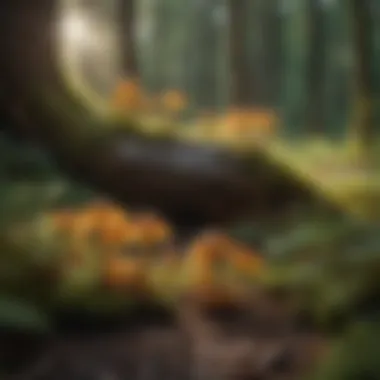
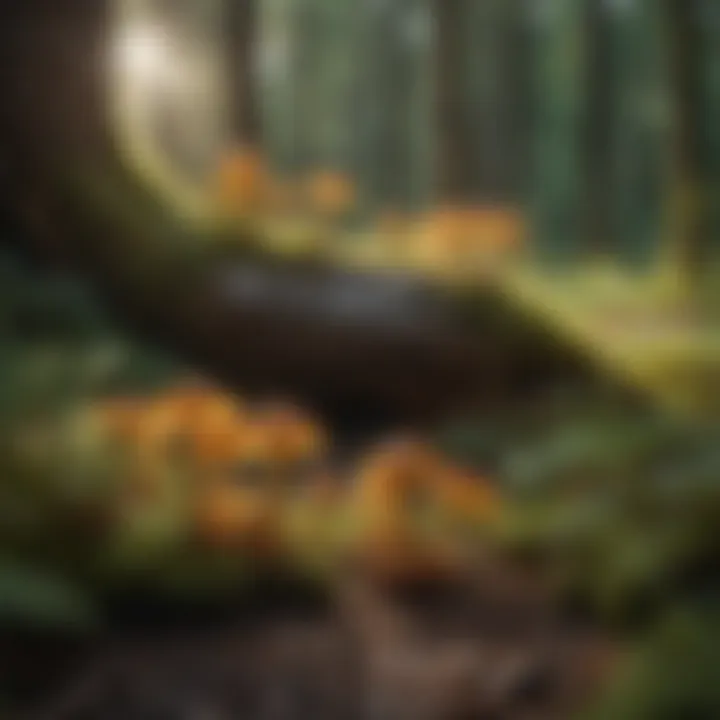
Intro
Mushrooms play a pivotal role in the ecology of Washington State's forests. Their presence marks a vibrant tapestry of life in diverse woodland ecosystems. Understanding these fungi extends beyond mere identification; it involves delving into their ecological roles, economic significance, and cultural importance. This article serves as a comprehensive guide, aiming to inform forestry professionals and academics about the nuances of mushrooms native to this unique region.
Understanding Woodland Ecosystems
The forests of Washington State are not just collections of trees; they are intricate ecosystems where myriad organisms interact.
Importance of Biodiversity in Forests
Biodiversity is essential for maintaining healthy ecosystems. In Washington, diverse species of mushrooms contribute to nutrient cycling, decomposing organic matter and returning nutrients to the soil. Mushrooms, such as the morel (Morchella spp.) and chanterelle (Cantharellus spp.), represent only a fraction of the fungal diversity that supports various life forms. Their varied interactions with trees and other organisms foster resilience against invasive species and climatic changes.
Role of Forests in Climate Regulation
Forests significantly impact climate regulation by sequestering carbon dioxide and maintaining humidity through transpiration. The diverse mycological life within these forests also plays a part in this system. Fungi help in soil formation and stabilization, further contributing to forest health. Preserving mushroom diversity is not just about appreciation; it is vital for the overall health of the ecosystem.
Sustainable Forestry Practices
Implementing sustainable forestry practices is crucial in maintaining the balance between ecological integrity and human interests.
Principles of Sustainable Forestry
Sustainable forestry involves managing forest resources to meet current needs without compromising future generations. This includes selective logging, habitat conservation, and careful monitoring of mushroom populations. The aim is to maintain a thriving ecosystem that supports both commercial interests and biodiversity. Effective management can enhance the growth of edible mushrooms while ensuring the ecosystem remains robust.
Case Studies of Successful Implementations
Various organizations in Washington have successfully demonstrated sustainable practices. For instance, the Pacific Northwest research stations have employed integrated forest management strategies that enhance both tree and mushroom growth. Sharing these case studies helps inform professionals about effective approaches in forestry while also benefiting local communities.
Woodland Stewardship Techniques
Effective stewardship is crucial for maintaining the integrity of woodland environments where mushrooms flourish.
Forest Management Plans
Creating well-defined forest management plans is essential. These plans lay out clear objectives for conservation and resource use. In Washington, some plans emphasize the importance of preserving habitat for native fungi, recognizing their role in the larger ecosystem context.
Conservation Strategies
Conservation strategies should include monitoring mushroom habitats and protecting them from overharvesting. Engaging local communities in conservation efforts can raise awareness of the importance of mushrooms. This approach fosters a sense of shared responsibility and enhances local knowledge about preservation.
"Understanding the critical roles mushrooms play can lead to more informed conservation strategies that benefit both ecosystems and communities."
Overview of Mycology in Washington State
The study of mushrooms, known as mycology, plays a vital role in understanding the biodiversity of Washington State. This region offers a unique climate and diverse habitats that support a plethora of fungal species. Understanding mycology in this area is essential for various professionals, including ecologists, foresters, and conservationists. Knowledge about local fungi not only enriches our appreciation for nature but also aids in identifying potential sources for medicinal and edible varieties.
Ecological Importance of Mushrooms
Mushrooms contribute to ecosystems in profound ways. They participate in nutrient cycling, breaking down organic matter, which enriches the soil. This process ultimately supports plant growth, providing an essential service to the ecosystem. Many species form symbiotic relationships with trees and other plants, assisting in water and nutrient absorption. The presence of fungi can serve as indicators of environmental health, showcasing the interconnectedness of life forms.
"The role of mushrooms extends beyond mere decomposition; they are integral to the vitality of forest ecosystems."
Mushrooms also provide habitats for various wildlife species. Birds, insects, and small mammals often rely on fungi for food. This relationship highlights the complexity of food webs and the significance of preserving mushroom populations to sustain biodiversity.
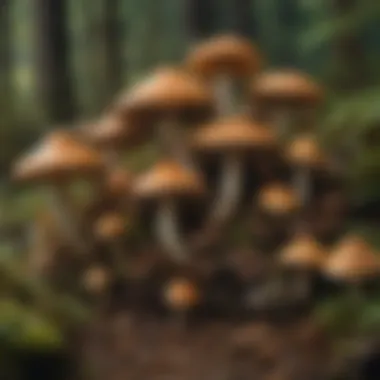
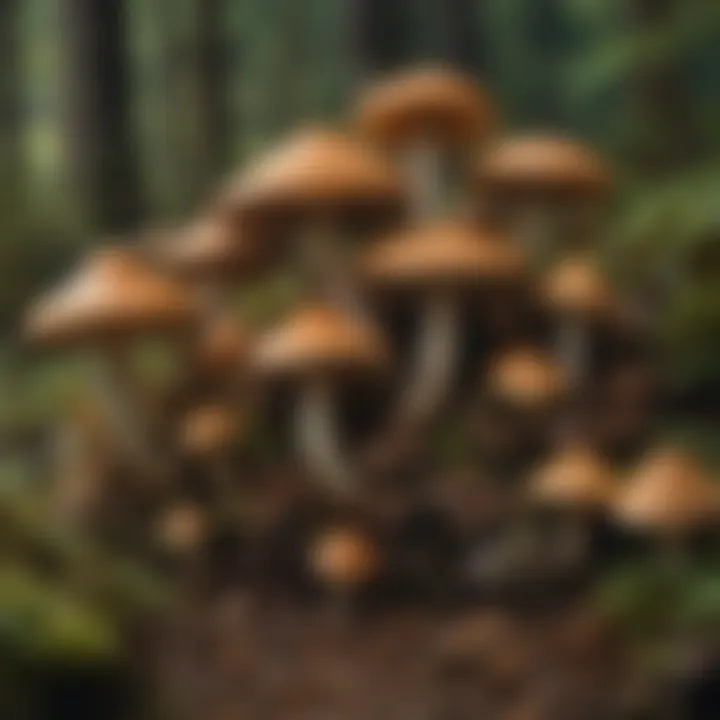
History of Mushroom Identification in the Region
The history of mushroom identification in Washington State is rich and multifaceted. Indigenous peoples of the region have used mushrooms for centuries, both as sustenance and for medicinal purposes. Their extensive knowledge of local fungi has been passed down through generations, revealing the depth of their connection to the land.
In the 19th and early 20th centuries, scientists began to systematically document the fungal species present in Washington. Notable mycologists contributed to the academic study of fungi, expanding the understanding of their classification and ecological roles. This period saw the emergence of formal foraging practices and the establishment of community interest in local mushroom species.
Today, the efforts of citizen scientists and fungi enthusiasts continue to enhance our understanding of mushroom biodiversity. Community mapping projects enable a more comprehensive picture of the mycological landscape, allowing for ongoing exploration and research. This historical progression informs current practices and emphasizes the need for continued exploration into the world of mycology.
Common Mushrooms Found in Washington State
Understanding the common mushrooms found in Washington State is important for a variety of reasons. First, this region's unique climate and biodiversity create a habitat for a wide range of fungi, many of which have ecological roles that contribute to forest health. Second, knowledge of local mushrooms can enhance foraging experiences for both enthusiastic amateurs and seasoned professionals. Awareness of edible varieties and toxic species is vital to both enjoy and stay safe in this pursuit.
In Washington State, mushroom foraging is not only a popular hobby but also a significant aspect of local culture and cuisine. Mushrooms such as chanterelles, morels, and puffballs are sought after for their culinary potential. However, it is crucial to approach foraging with care and respect for the environment.
Identifying Edible Varieties
Identifying edible mushrooms requires knowledge and careful observation. Foragers should familiarize themselves with characteristics that distinguish safe varieties from toxic ones. Edible mushrooms in Washington include:
- Chanterelles (Cantharellus cibarius): With a golden-yellow color and trumpet shape, these mushrooms emit a fruity aroma and have a peppery flavor. They often grow in coniferous woods.
- Morels (Morchella esculenta): Recognized by their distinctive honeycomb appearance, morels are seasonal and found primarily in spring. Proper cooking is necessary, as they should never be consumed raw.
- King Bolete (Boletus edulis): Also known as porcini, this mushroom is delicious when cooked. It features a brown cap and a thick, bulbous stem. King boletes favor coniferous and deciduous forests.
Identifying mushrooms often involves examining several characteristics, including cap shape, gills, stem, and habitat. Anyone interested in foraging should consider joining local mycology clubs or attending workshops to enhance their skillset in mushroom identification.
Toxic Species to Avoid
It is equally important to be aware of toxic mushrooms that can cause serious health issues. Two notorious examples include:
- Death Cap (Amanita phalloides): This is one of the deadliest mushrooms, characterized by a greenish cap. Illness may not manifest until days after ingestion, complicating diagnosis and treatment.
- Destroying Angel (Amanita virosa): Another deadly species, it has a white appearance and can be mistaken for edible varieties. Its toxins rapidly damage the liver and kidneys, making immediate medical help necessary.
Here are some tips for avoiding toxic mushrooms:
- Always perform thorough research before foraging.
- Use a reliable field guide with clear images.
- When in doubt, do not consume.
"Foragers must prioritize their safety by learning to recognize harmful species and understanding local fungi before venturing into the wild."
Understanding the spectrum of mushrooms in Washington State opens up culinary and ecological opportunities. Both edible and toxic varieties deserve attention and respect in the complex web of life that fungi represent.
Ecological Roles of Native Mushrooms
Mushrooms play crucial ecological roles within the environments of Washington State. Their impacts are profound, influencing not just their immediate surroundings but also larger ecological networks. Understanding these roles provides insights into their importance for both the forest ecosystems and the broader biosphere.
Symbiotic Relationships with Trees
Mushrooms often engage in symbiotic relationships with various tree species, forming what is known as mycorrhizae. This partnership benefits both the fungi and the trees. The fungi connect with tree roots, enhancing water and nutrient absorption. In return, the mushrooms receive carbohydrates produced during photosynthesis.
Particularly, species like Agaricus bisporus and Lactarius deliciosus demonstrate these symbiotic interactions. These relationships facilitate the exchange of nutrients and aid in soil health. The elaborate networks formed by these mycorrhizal fungi create a thriving ecosystem vital for tree survival and growth. Researchers have shown that trees associated with mycorrhizal fungi tend to be more resilient to parasites and diseases.
In essence, without mushrooms, many tree species would struggle to thrive in the nutrient-poor soils often found in Washington's forests. The decline in mushroom populations could lead to decreased forest resilience and biodiversity.
Decomposers and Nutrient Cycling
Mushrooms serve as decomposers, breaking down organic matter such as dead trees and fallen leaves. This process is essential for nutrient cycling in ecosystems. As mushrooms decompose organic matter, they release nutrients back into the soil, making them available for plants and other organisms.
Decomposing fungi like Pleurotus ostreatus (also known as the oyster mushroom) play a significant role in this cycle. They help in affore meny environmental problems by breaking down toxins and enriching the soil. Their mycelium networks not only promote soil health but also support diverse forms of life in the forest.
The importance of this role cannot be understated. Healthy nutrient cycling is fundamental for sustaining plant life and, consequently, animal life as well. It maintains the productivity of the ecosystem, contributing to overall ecological balance.
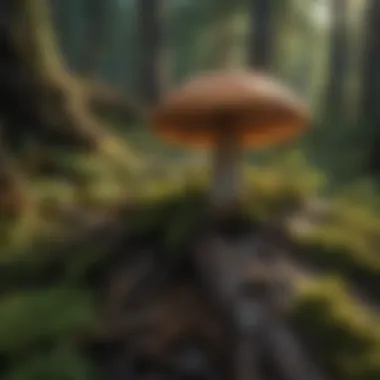
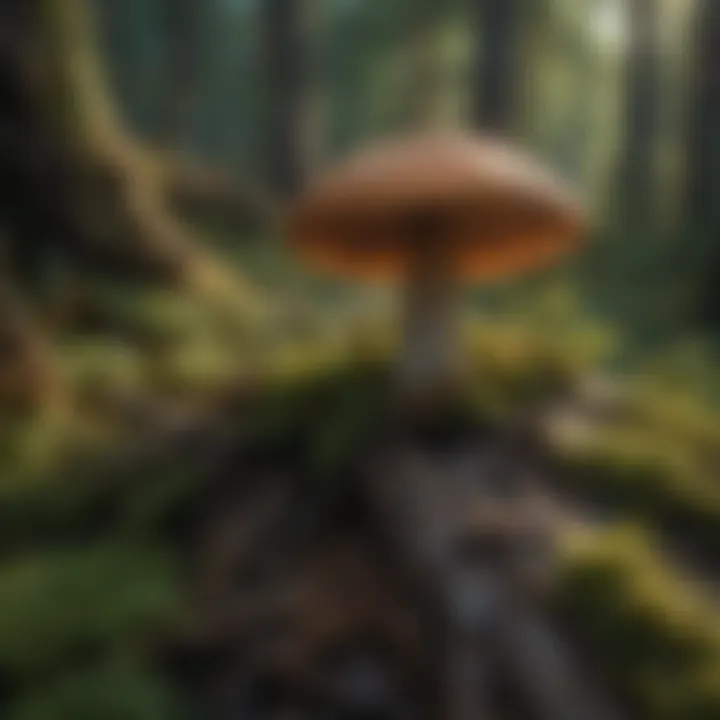
Mushroom Habitat and Distribution
Understanding the habitat and distribution of mushrooms in Washington State sheds light on their ecological roles and significance. Mushrooms are not randomly found; they thrive in specific environments dictated by numerous factors such as moisture, temperature, and available nutrients. This overview will explore two primary habitats: forests and woodlands, and wetlands and grasslands, highlighting their distinct qualities and the types of mushrooms that inhabit them.
Forests and Woodlands
Washington State is renowned for its vast forests and woodlands, which constitute some of the most biodiverse ecosystems. These regions supply necessary conditions for mushrooms to flourish. The dense canopy of trees, such as Douglas firs and bigleaf maples, creates a humid, shade-rich environment crucial for mushroom growth.
- Nutrient-rich substrates: Fallen leaves, decomposing wood, and plant matter contribute to nutrient cycling, providing food sources for fungi.
- Microclimate diversity: Varied elevations and microclimates within forests can lead to distinct communities of mushrooms. For example, morels often appear in disturbed areas, while chanterelles thrive in healthy forest layers.
The interaction between trees and fungi often forms mycorrhizal partnerships, which can alter soil structure and nutrient availability. Such relationships benefit the trees while aiding in the survival and distribution of mushrooms.
"Fungi are often overlooked but play integral roles in terrestrial ecosystems, especially in forests where their contributions to nutrient cycling are invaluable."
Wetlands and Grasslands
Contrasting significantly with forests, wetlands and grasslands offer a different ecological niche for mushroom species in Washington State. These environments are frequently influenced by hydric soils, fluctuating water levels, and diverse plant life, all contributing to unique fungal habitats.
- Water retention: Wetlands provide consistent moisture, which is critical for many fungi that prefer damp environments. Species like the oyster mushroom can often be found in these areas.
- Wild grasses and herbaceous plants: In grasslands, the dynamic interplay between various plants can lead to colonies of mushrooms that emerge predominantly in spring and early summer. Fungi such as the puffball mushroom rely on these habitats for germination and development.
Mushrooms in wetlands also participate actively in nutrient cycling and are essential for decomposition processes. They help break down organic materials, ensuring that nutrients are recycled back into the ecosystem.
Cultural Significance of Mushrooms in Washington State
Mushrooms hold a critical place in the cultural heritage and daily lives of people in Washington State. Their significance goes beyond mere culinary uses. This article explores two vital aspects: Indigenous uses and traditions, and modern foraging practices. Understanding these cultural dimensions enhances appreciation for the diverse mycological landscape found here.
Indigenous Uses and Traditions
For many Indigenous tribes in Washington State, mushrooms are not only food sources, but they are also integral to cultural identity and traditional practices. Various species, such as the Matsutake and Chanterelle, have been harvested for generations. These mushrooms are used in traditional dishes that reflect the natural flavors of the region.
Indigenous peoples have long recognized the medicinal properties of mushrooms. Certain varieties are believed to have health benefits, used in herbal remedies or as part of spiritual practices. They often blend culinary use with stories and rituals, creating a rich tapestry of cultural understanding.
Harvesting practices among Indigenous tribes are guided by respect and sustainability. The knowledge of when and how to gather mushrooms is often passed down through generations.
Modern Foraging Practices
In recent years, modern foraging has gained popularity in Washington State. Many individuals, including enthusiasts and culinary professionals, have turned to the woods in search of wild mushrooms. This movement emphasizes not only the enjoyment of mushrooms but also sustainability and responsible harvesting.
Foraging workshops and guided tours have become common, aiming to educate people about safe mushroom identification and the ecological roles of fungi. Online communities, like those found on Reddit, share information and personal experiences, fostering a supportive network among foragers.
Key points of modern foraging include:
- Knowledge of local mushroom species to ensure safety.
- Understanding the ecological impact of harvesting.
- Engaging with local food movements that emphasize sourcing from the environment.
"For many, foraging represents a connection to nature and a deeper understanding of the ecosystem."
Conservation of Mushroom Species
Preserving the existence of mushroom species is not just an ecological necessity; it is also a pivotal part of sustainable practices within Washington State. Mushroom biodiversity plays several roles in ecosystems, functioning as decomposers and symbiotic partners for various plant life. The decline or extinction of any mushroom species may disrupt local ecological equilibria and affect the health of surrounding flora and fauna, resulting in cascading effects.
One significant aspect of conservation efforts lies in understanding the threats that mushrooms face, including habitat destruction, climate change, and pollution. These factors not only endanger individual species but also the intricate relationships they have with other organisms. By prioritizing conservation initiatives, it becomes possible to protect these networks and the essential services mushrooms provide.
Another crucial consideration is public engagement in conservation efforts. Informing the community about mushrooms' ecological value can foster more significant support for protective measures. Therefore, conservation strategies must engage various stakeholders, including researchers, amateur mycologists, and local governments, ensuring a holistic approach to discussing mushroom conservation.
Threats to Mushroom Biodiversity
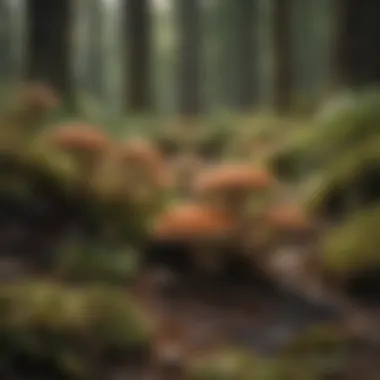
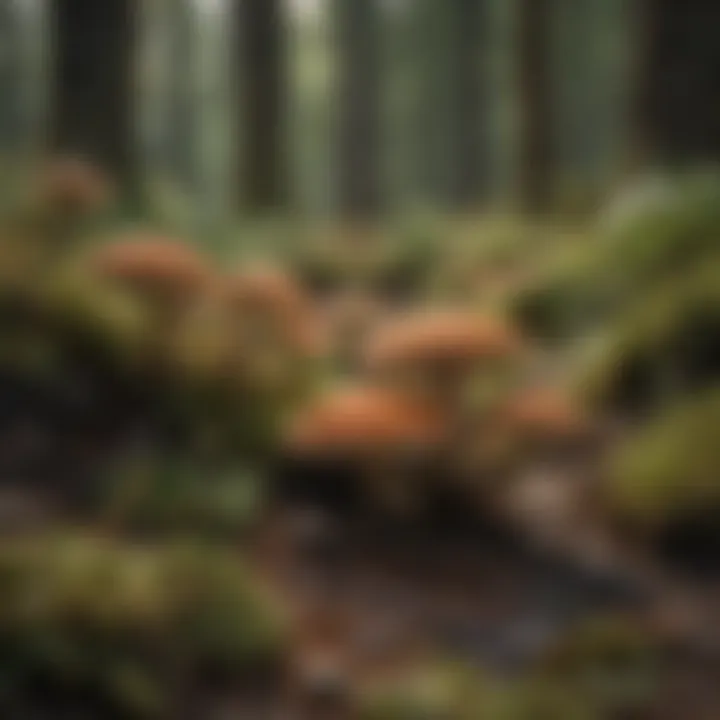
Mushrooms face a myriad of threats that jeopardize their existence in Washington State. The most pressing issues include:
- Habitat Loss: Urbanization and agricultural expansion lead to the fragmentation of natural habitats. This can limit the growth areas necessary for specific mushrooms.
- Climate Change: Shifts in climate alter ecosystems, affecting seasonal patterns that mushrooms rely on for growth and reproduction. Increased temperatures or altered precipitation can make ecosystems inhospitable for certain species.
- Pollution: Chemical runoff from agricultural fields can contaminate soil and water sources, negatively impacting not only mushrooms but also the fungi-plant relationships necessary for nutrient exchange.
- Invasive Species: Non-native plants and fungi can outcompete native mushroom species for resources, disrupting existing ecosystems.
These factors necessitate a concerted effort to monitor and mitigate their impacts, focusing on identified high-risk areas that are crucial to mushroom survival.
Strategies for Effective Conservation
To promote effective conservation of mushroom species, several approaches can be adopted:
- Habitat Preservation: Protecting intact ecosystems through legislation or land management practices can help secure spaces vital for mushroom growth. This might include setting aside areas as conservation reserves or creating buffers around important habitats.
- Research and Monitoring: Conducting scientific research on mushroom populations and their habitats is essential to identify trends and threats. Long-term monitoring can reveal changes in distribution and inform conservation strategies.
- Community Involvement: Engaging local communities through educational programs can raise awareness about the importance of mushrooms and encourage citizen participation in conservation efforts. Initiatives such as mushroom foraging workshops and identification classes can promote understanding.
- Collaboration with Stakeholders: Building partnerships among various groups, such as conservation organizations, universities, and governmental agencies, can amplify conservation efforts. Each entity brings unique skills and resources that can enhance mushroom preservation initiatives.
- Support for Sustainable Practices: Encouraging sustainable agricultural and forestry practices reduces the negative impacts on mushroom habitats. Responsible land use can balance development demands while maintaining ecological integrity.
By implementing these strategies, Washington State can foster a robust conservation framework that ensures mushroom species thrive well into the future.
The Role of Citizen Science in Mycology
Citizen science is increasingly vital in mycology, especially concerning the rich diversity of mushrooms in Washington State. This collaborative approach enables ordinary people to contribute to scientific research, bringing together enthusiasts and professionals. The involvement of the community not only aids in data collection but also raises awareness about fungi and their ecological roles.
Through various initiatives, citizen scientists can engage in mushroom mapping projects. These efforts contribute significantly to understanding the distribution of mushroom species, often providing data that researchers may not have the resources to gather on their own. By utilizing platforms like iNaturalist and joining local mycological societies, participants can document and share their findings. This grassroots effort enhances the overall knowledge base and creates a more comprehensive picture of fungal diversity in Washington.
Citizen science can also foster a sense of ownership and responsibility for local ecosystems. When individuals realize their contributions have scientific value, they are more inclined to protect and advocate for their environments. Moreover, it encourages learning through direct interaction with nature, promoting a deeper appreciation for biodiversity.
"Engaging in citizen science transforms the monotonous process of data collection into a vibrant discussion around fungi, bridging gaps between the scientific community and the general population."
Engaging Communities in Mushroom Mapping
Mushroom mapping is a practical way to involve communities in citizen science. Mapping involves documenting various mushroom species in specific locations, providing critical information for researchers. This activity helps in identifying patterns, such as the geographical distribution of mushrooms and seasonal appearances.
Local workshops and foraging events are effective in educating participants about mushroom identification and their ecological roles. Educational events encourage more people to engage actively; they learn to recognize edible and toxic species, enhancing their ability to contribute meaningful data. Tools such as smartphone apps are pivotal; they allow amateurs to capture photos and upload findings, enriching the scientific database with real-time information.
Engaging community members in such mapping activities fosters camaraderie and collaboration, which are essential for successful citizen science projects. Increased knowledge and awareness will lead to stronger community ties around the preservation of mushroom habitats.
Contributions to Mycological Research
The contributions of citizen scientists to mycological research are profound and far-reaching. Those who participate in projects provide vast amounts of data that can enhance scientific understanding of fungi's ecological roles. For example, data collected by community members can highlight shifts in fungal populations, indicating environmental changes or the impacts of climate change. By documenting these variations, citizen science projects can help identify trends and potential threats to specific species.
Additionally, citizen scientists often uncover previously undocumented species, expanding the current knowledge base. These findings can assist researchers in establishing conservation priorities and strategies. Ultimately, the contributions made through citizen science are invaluable for informing policy and guiding sustainable practices in mycology and related fields.
The collaboration between citizens and scientists strengthens the field of mycology, especially in a biodiverse region like Washington State. Whether through engaging local communities or contributing to critical research, citizen scientists play a crucial role in shaping the future of mycology.
The End
In the examination of mushrooms native to Washington State, the conclusion serves as a critical reflection point that encapsulates the findings and discussions throughout the article. A comprehensive understanding of Washington's mycological landscape reveals not only the diversity of fungi present but also their ecological significance, cultural connections, and the imperative for conservation efforts. This summary aims to emphasize several key elements.
First, the ecological importance of mushrooms cannot be overstated. They play crucial roles in nutrient cycling and forming symbiotic relationships with trees, ultimately affecting the health of ecosystems. By understanding these roles, forestry professionals can better manage forest health and biodiversity.
Second, the discussion on edible versus toxic species provides a practical guide for foragers, ensuring safe mushroom hunting practices. As mentioned earlier, mycological knowledge can enhance local gastronomy and economic opportunities through responsible foraging.
Moreover, the cultural significance underscores how mushrooms weave into the fabric of local traditions, especially among Indigenous communities. Recognition of these historical uses promotes respect for cultural heritage and sustainable practices in harvesting.
In summary, the synthesis of the above elements leads to a clear understanding: comprehensive mushroom studies in Washington State not only contribute to scientific knowledge but also enrich local culture and promote ecological stewardship.
This understanding paves the way for future research and deeper community engagement.
Future Directions in Mushroom Studies
Looking ahead, the future of mushroom studies in Washington State is promising yet poses various challenges. Initiatives aimed at enhancing citizen science involvement could play a pivotal role in mapping and understanding mushroom distributions. Engaging the public in mushroom identification and documentation fosters a grassroot approach to biodiversity conservation.
Research could further explore the potential benefits of fungal species in sustainable practices, such as their application in bioremediation and sustainable agriculture. Studies focusing on the impacts of climate change on fungal life cycles and distribution patterns may also provide invaluable insights into broader environmental challenges.
Additionally, collaboration among researchers, local communities, and conservation organizations can lead to comprehensive strategies tailored to protect and promote mushroom biodiversity. Continuous education and outreach will ensure that the rich mycological resources are appreciated, understood, and preserved for future generations.







